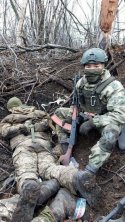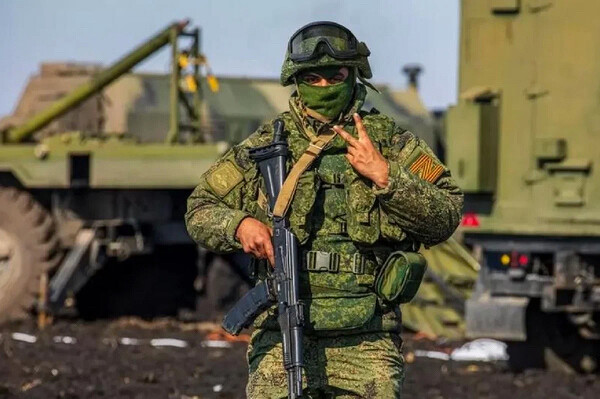Bollocks. Russia created the Mir debit and credit card to replace Visa and Mastercard. [...]
And in tanks and armored vehicles you can see a huge difference. They built hundreds of BMD-4M IFVs at a rate of over a hundred a year. Hundreds of BMP-3 IFVs again over a hundred a year. They upgraded hundreds of T-72B tanks to B3 and B3M status. They upgraded like a thousand BTR-80s to BTR-82A standard. They replaced the Tochka with Iskander. They also produced enough Ratnik kit to equip all their standing army.
I think it's possible to have a rational discussion about Russian preparedness for this conflict.
Gelgoog has already described measures taken by the Russians to protect themselves from the sanctions war. They seem to have performed above expectations in this regard.
OTOH, many 'complain' on-line that Russia should have achieved military results more quickly. This opens a discussion on Russia's military modernization.
Again, Gelgoog has indicated areas in which the Russians produced many AFV for their own forces. [We saw those BTR-82A being used in large war-preparatory exercises in 2021. Much 'heavy equipment' was parked near Ukraine after the exercises.]
The criticism on this forum and elsewhere of Russian preparations tends to focus first and foremost on drones and ALGM. A child could have told Shoigu that drones would be used en masse, and be vital to the war effort. However, Russia spent much time and development funds on sophisticated drones, some of which have only limited presence or are not available yet. The issue of PGM is compared with China, which is said to practice with air-launched PGMs at a much higher rate.
Russia eventually turned itself around on the issue of drones, mass-deploying those Iranian designs. I don't know if their PGM situation is from a lack of PGM + training, or if they don't have a means of providing targeting data for these air-launched weapons. Ukraine is a big place to hide in.
The RuAF in general is not used as lavishly as NATO countries do. What is it, 200 sorties per day instead of 1000+? There is talk here that wear on aircraft is a big deal. Russian doctrine may not emphasize the air force as much as NATO, but to what degree are they deficient in desired aircraft numbers? They have a respectable ability to produce aircraft (SU-35, SU-30, SU-34), so if numbers are inadequate then there is a budget issue.
[They are using up SU-25s, and it's unclear if they have the ability to produce them. Speaks to poor planning if they are going to run out.]
When looking at the overall modernization of ground forces, how is it versus what it could have been? We have to measure Russia against what it is capable of. They produced many T72B3, but only got in late producing the better T72B3M. Cost-benefit is the primary calculation here: you get several T72B3 for each T90, and many for each T-14. They are fighting on a very large front. Having enough decent tanks is more important than having a smaller number of good tanks. [T-62 and T-55 are being used/considered in this war, because having an armoured box with a gun is more important than a T-90M that isn't there.]
Did Russia make the right choice [for them] producing so many T-72B3? Probably, although B3M is better. The real problem in their AFV pool is the rest of the tracked IFV. They had the technology to start producing Berezhok turrets for BMP-2 back in 2016. How many were actually converted? Could they all have been converted by 2022? Was it worthwhile to create and field the new BMP-1 with 30mm cannon? They recently started producing an uparmoured variant of the BMP-3M. Why not start in 2014? Middle-Eastern countries got uparmoured BMP-3 [granted, non-amphibious. But they don't seem to use that capability.] So right now, Russian soldiers are driving around in standard BMP-3Ms, or sitting on top of BMP-2s.
They 'modernized' the MTLB, which is a useful logistics vehicle. But there was a proposed BMP-3 based logistics vehicle that they could have produced, but did not. OTOH, we saw that they came into the war with armoured trains, which had been used in previous conflicts. Their train-based logistics have generally delivered large quantities of supplies, almost since the beginning.
Their artillery pool is a different story. The problem goes back decades. They could have modernized their existing, late-model Soviet 152mm MSTA SPG, and there was a Soviet program to do so. Instead, they got stuck trying to build Koalitsiya forever. Various useful upgrade programs for Soviet SPG were stalled, the new-gen SPG has not yet arrived. Arguably, they screwed up here. They are fielding a lot of equipment given the size of their budget, that is a success story. But the 'modernization' is not what it could have been. Big picture, they maybe didn't think artillery would be as important as it has been.
In terms of infantry equipment, they are on Ratnik-2 gear, with Ratnik-3 coming at some point. Unfortunately for them, NATO has delivered a lot of modern body armour to Ukraine, reportedly, so Russia is running to keep up. The AK-12 has been produced, but is seemingly hobbled by questionable decisions at the bureaucratic level [2-round burst?]. Soldiers have to buy parts to get AK-12 in the desired configuration. Arguably, the needs of the end-user have not been met in stock form.
Big picture, seems as if Russia had to concentrate funding on strategic weapons and air defense. ICBMs, hypersonic missiles, S-400 would reduce the risk of NATO intervention. Russia's powerful strategic force dramatically increases the 'cost' [suicide] of direct conflict with Russia. Submarine force is very expensive. Then, there is air force. At some point down the line, you have the ground-forces modernization. The need to protect Russia via strategic forces sucked up much of the money that could go to ground forces. Reminiscent of DPRK funding its nuclear program before its ground-force modernization.
The other issue is bureaucratic dysfunction. People who may be removed from daily use of equipment [like AK-12] making decisions on what it should be. Concentrating on gee-whiz weapons like 2-barrel Koalitsiya, which delayed development. Indecisiveness on procuring vehicle improvements such as Berezhok turret, and producing BMPT. Going further back, was it the right move to cancel BTR-90? It's likely that because of some bad decisions, vanity decisions, and indecisiveness that Russian ground-force modernization is not what it could have been.
Of course, all of this declines in importance if you are not fully utilizing your main ground forces anyway. A disproportionate amount of the fighting seems to have been conducted by Donbass militia, regional formations such as the Chechens, and high use of the airborne forces. The regular army seems to be frequently used in a supportive role, as artillery and tank support for those other forces. So you don't get to fully utilize modernized ground forces with BMP-3M, T-90MS, etc... if they are still sitting in Belarus.
So there's a complex interplay of funding availability, procurement decisions, and actual use of Russian combat forces. I haven't talked much about RuAF, I'm sure there is a big laundry list of things they should have / be doing according to members here. There are interesting arguments / reasons over whether ground force modernization could have been more extensive.


